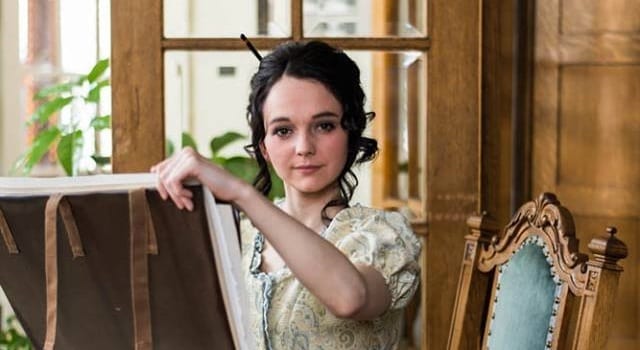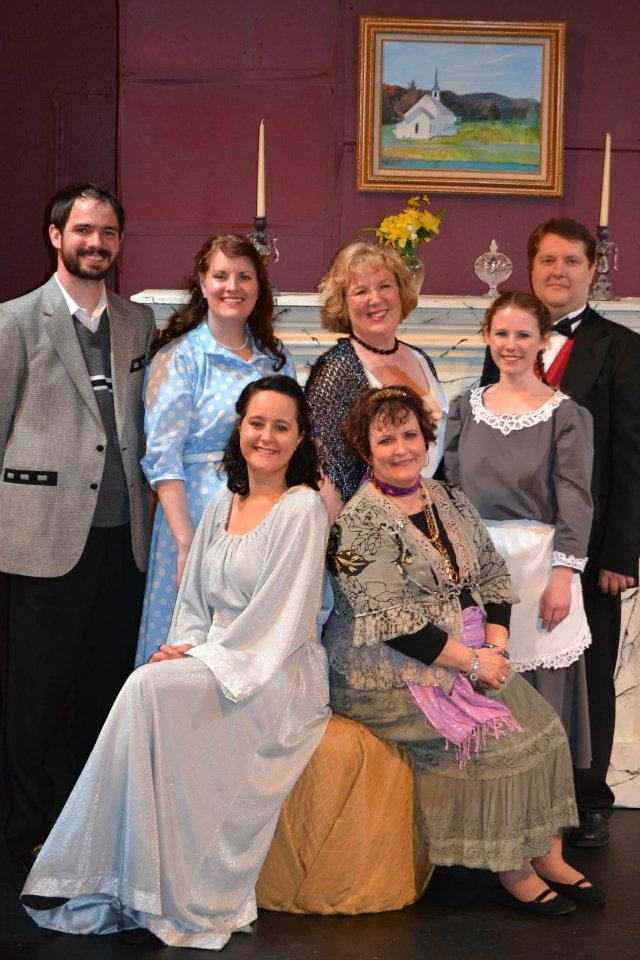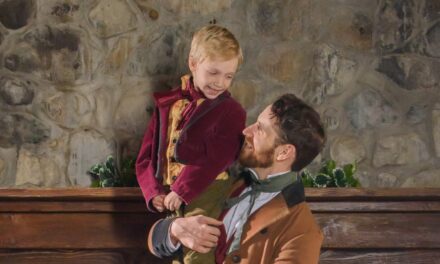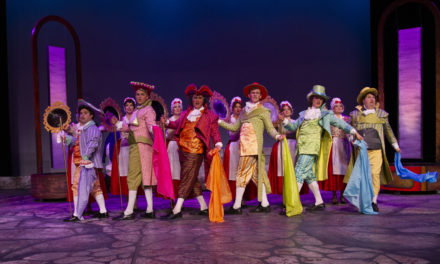OGDEN — Often as an audience member, I want to passively sit and relax and to just let the performance happen—to simply be entertained. I see nothing wrong with this—and find myself seeking escapism and a “fun” night out when I go to see most musicals and plays. Yet despite the fact that Weber State University’s production of Tom Stoppard’s award-winning Arcadia is by no means an “easy” play, I highly recommend it. I went into Arcadia knowing nothing about the play except that it was by Tom Stoppard. But I left wanting to see it performed again, to study its text, and to understand more deeply what Stoppard was trying to say.
On the surface, this play is an entertaining piece that requires focused attention to follow the witty dialogue, period language, and academic discourse. But upon closer study, Arcadia expands to become a multifaceted treatise on passion, art, time, the universe, physics, death, life, and determinism (among other things). That director Jennifer A. Kokai had the guts to take on this piece is impressive alone. The fact that she actually was able to mold a production that makes sense and has actors who deliver the often intellectual lines in relatable ways is simply incredible.
Sadly, British playwright Tom Stoppard’s plays are not often produced in Utah, which is unfortunate, given that Stoppard has won dozens of awards (including 4 Tony Awards for Best Play) and authored 35 plays to date. My theory on why more Utah theatres won’t tackle Stoppard is because of the challenge such a production requires. Stoppard is not mindless entertainment. His plays are incredibly complex and often delve into advanced philosophical, scientific, and mathematical concepts. But Stoppard done right can be a parabolic experience in which an “entertaining” surface understanding gives way to deepened understanding. In other words, what you put into such a complex work of art directly relates to what you get out of it.
Arcadia alternates between two sets of characters in two time periods in the exact same space. The play opens in 1809 in the English sitting room of Sidley Park, where a tutor named Septimus Hodge (played by Scott Garner) and his precocious thirteen-year-old pupil, Thomasina Coverly (played by Katie Jones), are discussing a very modern topic—the meaning of the phrase “carnal embrace”—in antiquated and proper British English. In this first scene, the audience is shoved immediately into a juxtaposition—an (eventually) straight-forward explanation of sex spoken in the formal language of wealthy 1800’s England. (Despite the mature dialogue, the content of the play overall would only rate between PG and PG-13.)
The play continuously delights in such juxtapositions—with discussions revolving around classicism vs. romanticism, light vs. darkness, chaos vs. order, science vs. intuition, lust vs. love, and more. The show continues with scenes switching between 1800’s to modern day, in which two historians, author Hannah Jarvis and literary scholar Bernard Nightingale, try to unravel the past of Sidley Park (a past the audience experiences even as discoveries are made). Adding to the intriguing contrast of past and present is the fact that all the scenes take place in the same room with the same furniture and props.
The main focal point of the set (designed by Van Tinkham) is a long wooden table, on which are spread a seemingly chaotic assortment of books, papers, and even a tortoise. Pieces of the future and the past are left to mingle together on the table—an iPad next to an inkwell, books placed by one time period left behind for another, and always, the tortoise. The only element of the set design that changes between time periods (except the characters themselves) is a simple projection (designed by Alex Thedell) meant to represent a view from a window. In the 1800’s scenes, the projection shows a gazebo and a proper English garden, while in the modern day, the projection has the same basic grounds but with a large, modern party tent and a red car.
Kokai chose a solid cast, as the distinctive characters are played well without exception. A few actors stood out in their delivery—starting with Katie Jones as Thomasina Coverly. Thomasina Coverly is a young (thirteen at the beginning of the play; sixteen by the end) and extremely intelligent young woman whose ideas and theories are well beyond her time. Jones’s portrayal of this spunky, inquisitive young woman is believable and loveable. From her sweet, high-pitched voice to the bubbling, bouncing way in which she moves and talks, Jones plays Thomasina with an energy and passion that is addictive to watch. In one scene, Thomasina violently mourns the ancient loss of Egypt’s Library of Alexandria. Though the library had been burned more than a thousand years before her time, Jones’s Thomasina expresses a deep anguish at the loss of knowledge. Her pain is believable and in its grandiose passion, humorous. It is in innocent, yet earnest moments like these that Jones’s Thomasina steals my attention and heart.
Playing opposite Jones during the majority of their scenes, Scott Garner portrays the scholar and tutor Septimus Hodge with maturity and wit. Septimus Hodge is somewhat of a loveable rogue. He is overall honest and open about his faults and his follies, though he willingly uses charm to smooth out unpleasant consequences. Garner is a charismatic and charming Septimus, and his comedic timing is quick and fits the witty dialogue. The ardent care Garner’s Septimus gives to Thomasina and the nurture with which he encourages her brilliant mind is tender and real. The final scene in the play, during which Septimus is at his most vulnerable before Thomasina, is Garner’s best moment.
Of actors playing the modern characters, my two favorites are Becca Lichfield as Hannah Jarvis and Aaron Ross as Bernard Nightingale. Much like Thomasina and Septimus, the characters Hannah and Bernard brim with ideas and wit. Yet unlike the usually affable Thomasina and Septimus, Hannah and Bernard are frequently at each other’s throats. Lichfield’s Hannah is a confident, no-frills woman with a deep intensity regarding her work. Lichfield’s intelligent facial expressions, relaxed and easy body language, and precise vocal mannerisms embody the intelligence and depth of Hannah. But as with any great partnering, Lichfield’s Hannah is at her best when she is set opposite Ross’s Bernard.
Ross is probably the funniest actor in the show, as he is a master of believably playing up the academic self-importance of the somehow still charming Bernard. Bernard is an unapologetic know-it-all (at least in his field of literature) and he isn’t shy about correcting or even ordering Hannah around. Bernard and Hannah are in a constant tug-of-war of ideas and the chemistry between Hannah and Bernard makes every argument all the sweeter. In the few moments when the two are getting along, particularly when Hannah and Bernard are both excitedly poring over some newly discovered historical detail, the energy between the actors is palpable.
The costumes in the show (designed by Lindsay K. Blackman) are period appropriate and suit each character well. Lady Croom’s regal pink brocade gown is stiff but beautiful, adding to the commanding, yet feminine, presence of Lady Croom as created by actress Ginny Spencer. By contrast, Blackman designed young Thomasina’s gown with delicate, flowing fabrics which sparkle and dance somewhere between blue, green, and gray. As Thomasina herself is the very image of exuberance, youth, and innocence, the dress reflects the character well. The gentlemen of the past are all dressed in pieces that look 1800’s appropriate, and the modern-day characters wear clothes that fit their personalities and lifestyles. Hannah Jarvis’s costume, for example, was simple and down-to-earth—jeans with messy boots appropriate for exploring gardens. Bernard Nightingale, on the other hand, wore a combination of slacks, button-down shirt, vest, and tie—smart but a little bit stuffy—much like the character himself.
Though I’m as much a sucker for a classic musical, Arcadia was a nice break from the norm. Weber State’s production stands as a thoughtful, passionate work of art presented by performers obviously invested in the material. The opportunity to experience this piece does not come often enough—and I highly recommend it to all adult audience members (though I do think it best suited for ages sixteen and up as the dialogues is heady, and there are discussions about affairs). Come to this play ready to be stimulated rather than lulled, enlivened not numbed. Bring a ready mind, and you will hopefully walk away as awed as I was at the mastery of Stoppard’s play.







